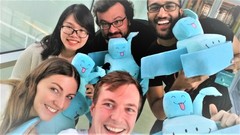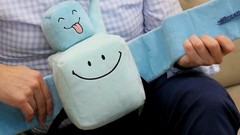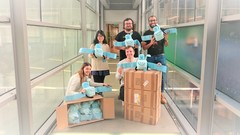We are very happy to announce the winners of the Design A Rosetta Toy Activity Contest. Of the best submissions for the contest, the jury panel has identified six main winners, who will receive a Rosetta Toy, as well as a teleconference with the astroEDU team, to have their idea made into an official peer-reviewed activity on the IAU astroEDU website. Nine other winning participants will also receive a Rosetta Toy.
There were many exceptional entries for our jury panel to judge, brought to us by educators, (amateur) astronomers and members of the UNAWE network. The jury panel consisted of astrophysicists, educators and science communicators, who were very impressed with the entries.
These are the winning entries and contestants, including summarised descriptions (in no particular order):
Rosetta and Philae's Adventures in Space, by Marinela Ivić from Croatia
Students adopt Rosetta and Philae for a week, create their own adventures and create a stop-motion video and reports. After students create their reports, these are binded into their very own story- and picturebook: Rosetta and Philae's Adventures in Space.
Autistic students learn about the solar system with Rosetta, María Consuelo Marazuela from Spain
With a series of pictograms, the Rosetta toy induces tactile sensations in a discreet and non-threatening way, facilitate understanding, stimulate senses and increase motivation of children in the autism spectrum.
Show me the way, by Nelly Ivanova from Bulgaria
A collaborative outdoor activity, where a simulated ground control will direct the Rosetta team to its landing site, with radio delay and without vision. The activity will follow the real story of the Rosetta mission.
Build your own Rosetta, by Styliani Tsilia from Greece
Rosetta will be introduced to explain the use of a model to the students. They will use the model to explain the different parts en learn about the design. They will then design, customise and name their own model with low-cost, simple household materials.
Inspired by Rosetta, by Marina Molla from Greece
An interdisciplinary approach that introduces a space related topic in the subject of language teaching, combined with art. Students will become journalist teams and write stories, combined with artwork. Finally, they will present their findings in the classroom, their Learning Diary, and the school’s blog.
Rosetta and the comet, by Lisbeth Enevoldsen from Denmark
Rosetta will introduce students to space, in particular comets and their chemical makeup. The teacher demonstrates how to make a comet from dry ice, gravel and soy sauce. Students will then fly the Rosetta toy around the comet and gather word cards to combine with pictures of space concepts.
These six main winners will receive a toy and be able to participate in a personal teleconference with the astroEDU team, who will support the winners to further develop their activities for submission on astroEDU. Once accepted, these submissions may also be included in the official Europlanet collections on comets!
Nine other entries will be rewarded with the Rosetta Toy for their inspiring efforts, and those are:
- Henrietta and Rosetta Travel on the Tail of the Comet, by Wilma Maria Mugnaini
- Centripetal Force, by André Freitas
- Knowing the Stars, by Melina Silva de Lima
- Young Explorers Club, by Anna Adamek
- Tell Your Story!, by Doina Otilia Filep
- A Comet in the Sky, by Fulvia Piccolo
- Light and Sound in "The invention of clear day", by Maria Teresa de Matos Paiva
- Rosetta and 3D Printing, by Jan Preclík
- Dear Comets, Be Our Guests, by Panagiota Alexandra Fratti
All winners are invited to send their photo’s and experiences with the Rosetta Toy during their educational activities and share them on our website.
This contest was made possible by the Rosetta Mission, Design & Data GmbH and IAU astroEDU. We thank them for their great work. We also thank all participants of this contest for their enthusiasm and inspiring efforts.
For more info on the contest, see here.















